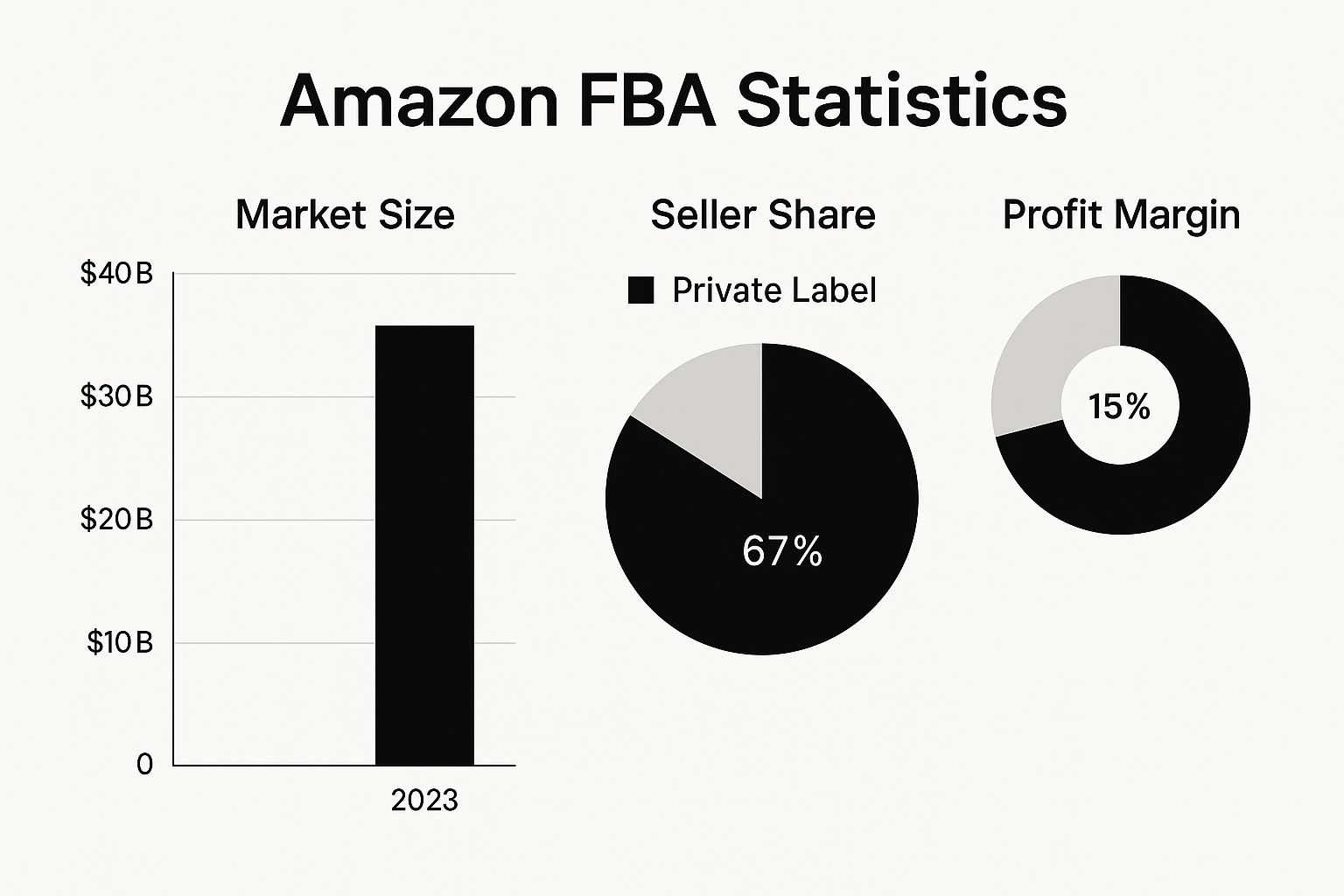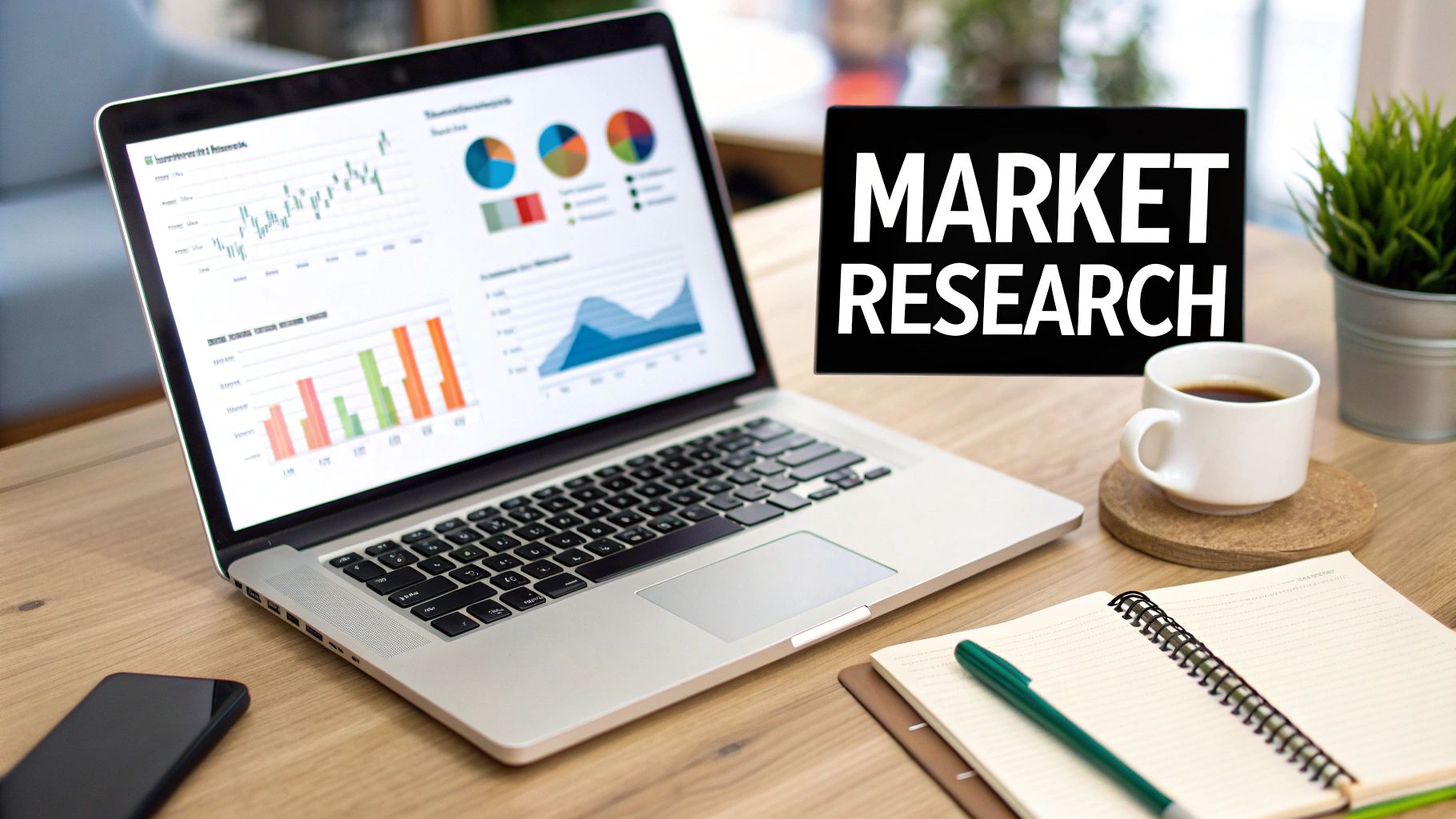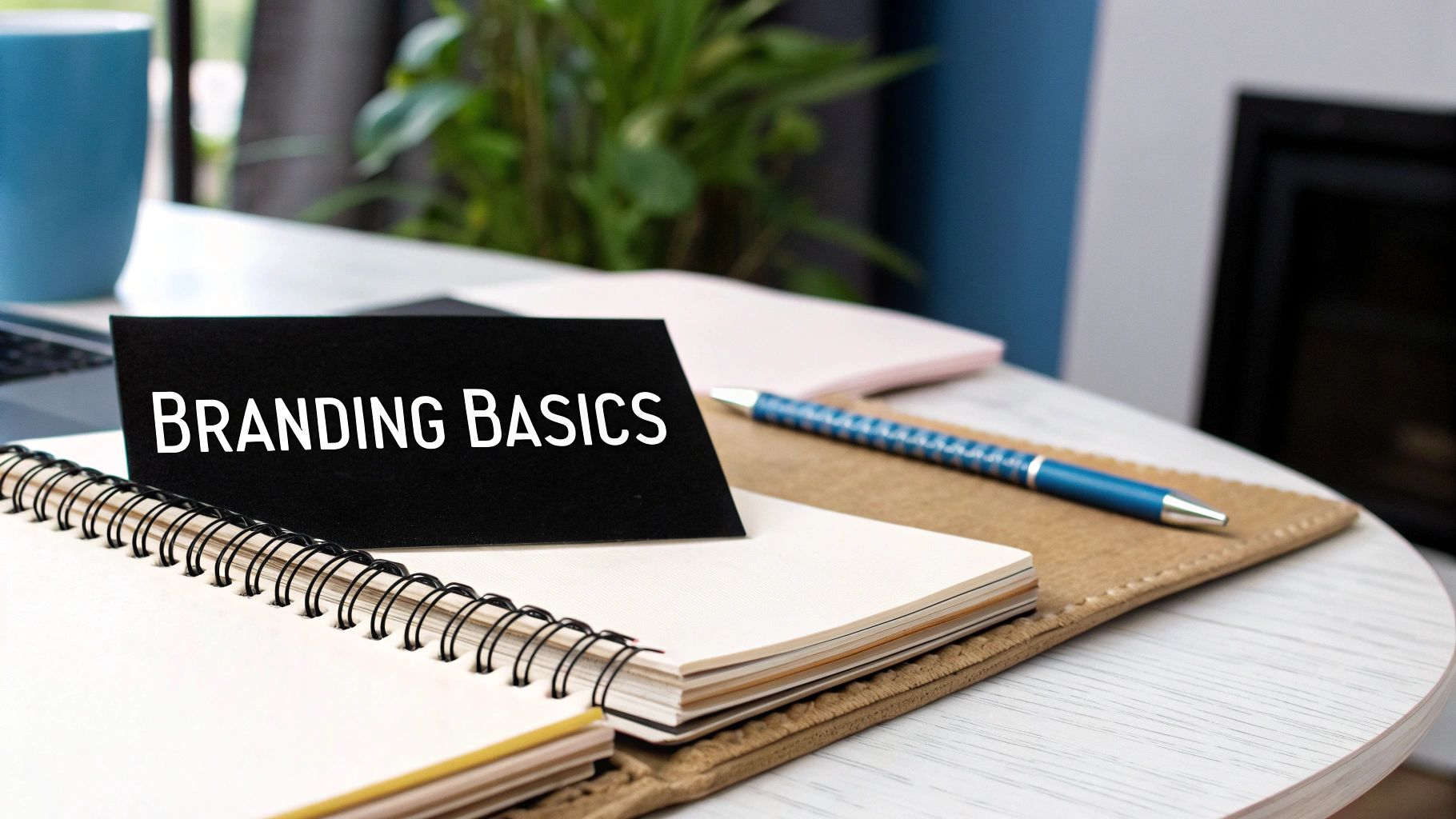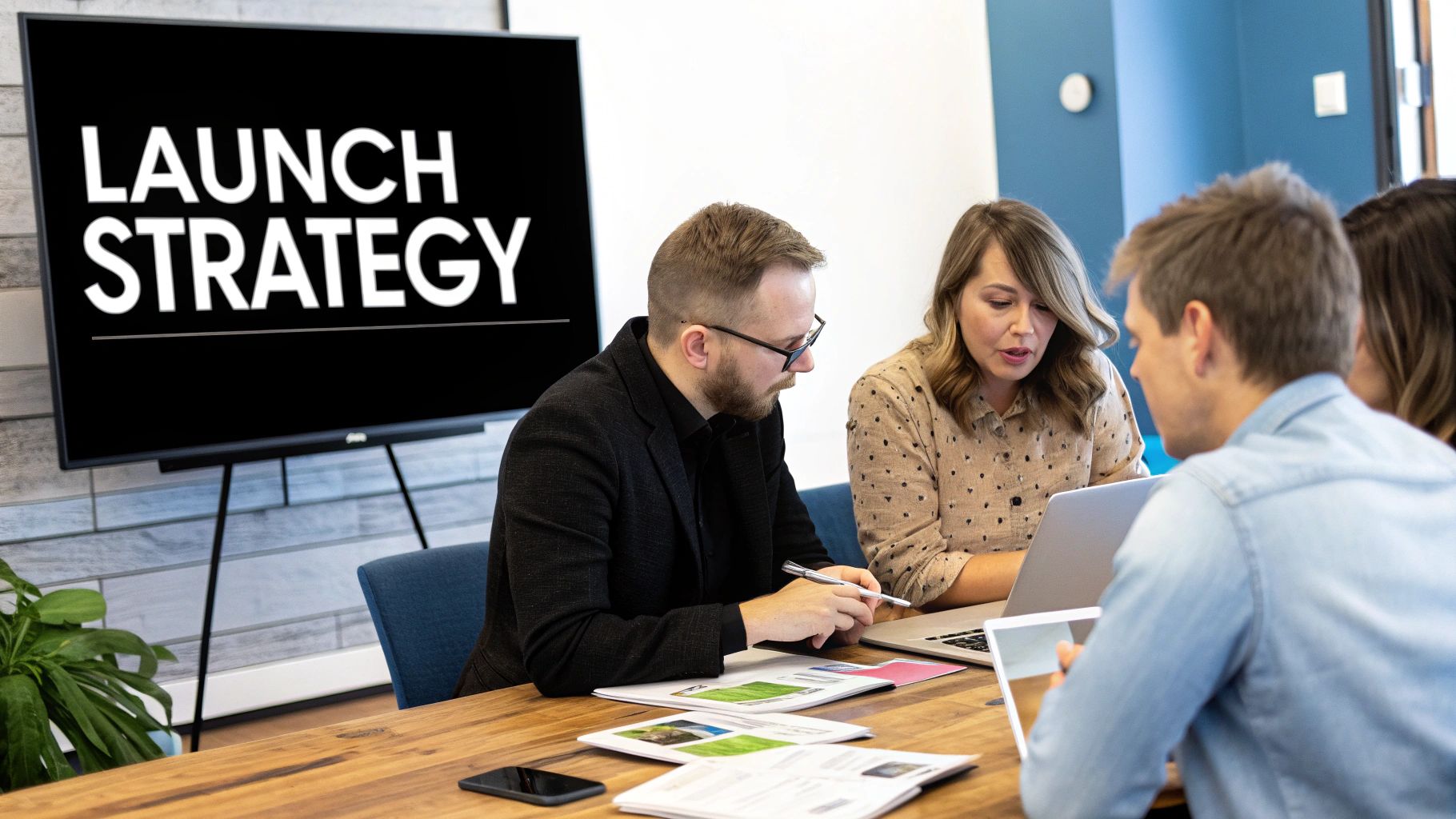Stay Updated with Everything about MDS
Thank you! Your submission has been received!
Oops! Something went wrong while submitting the form.

Chilat Doina
October 8, 2025
When you hear the term private label on Amazon FBA, you're really talking about building your own brand from scratch. You find a product, slap your own logo on it, and then let Amazon’s massive fulfillment network handle all the storing, packing, and shipping. This isn't just about flipping someone else's products; it's about creating a real, sellable business asset.
Before you even think about products or suppliers, the most successful Amazon businesses all start with a solid foundation. This part isn't glamorous. It’s all about strategic planning: getting real about the money involved, setting up your business the right way, and adopting the right mindset for the long haul.
Think of it as pouring the concrete for a skyscraper. If you skip these steps and build on sand, it might look okay for a little while, but it's going to crumble under the pressure of the competitive Amazon marketplace.
Let's get one thing straight: the myth of starting a successful Amazon brand with a few hundred bucks is just that—a myth. At least, not anymore. The reality is that launching a private label product has gotten a lot more expensive and competitive. You're looking at a total investment of anywhere from $4,000 to $12,000 for your first product. This jump reflects the fierce competition and Amazon's ever-increasing fees.
The Amazon marketplace is huge, with over 9.7 million sellers globally as of 2025. That's a lot of noise. But smart, strategic sellers can still carve out a profitable niche.
To give you a clearer picture of where that money goes, here's a realistic breakdown of what you should expect to spend.
This table should make it clear that you need to be properly capitalized to give your product a real chance at success.
How you structure your business from a legal standpoint has huge implications for your taxes and personal liability down the road. Lots of people start as a sole proprietor because it's easy, but forming an LLC (Limited Liability Company) is almost always the smarter move. An LLC creates a wall between your personal assets (your house, your car) and your business, which is critical protection if something goes wrong.
It’s always a good idea to chat with a legal or financial professional, but knowing your options from day one can save you from a massive headache and expensive restructuring later. A key part of this process is to create a brand identity that actually connects with the people you want to sell to.
The infographic below gives you a bird's-eye view of just how big the FBA market is, how dominant private label has become, and what typical profit margins look like.

What this data screams is that while the opportunity is massive, you're competing against a sea of other sellers using the exact same playbook. A strong brand is what will make you different.
At the end of the day, selling a private label on Amazon FBA is a brand-building game. You’re not just moving units; you’re creating a reputation and an experience for your customers. This demands a long-term perspective. You will have setbacks—shipping delays, bad reviews, supplier issues. Your ability to bounce back is your single most valuable asset.
Building a brand is about making a promise and keeping it. Your product quality, customer service, and listing presentation all work together to build trust with shoppers who have endless choices.
Focus on genuinely creating value and solving a problem. A killer ecommerce brand strategy is more than just a slick logo; it's the entire story and promise behind your products. Get this foundation right, and you'll be ready for whatever comes next.

Let's be blunt: your product choice is the single most important decision you'll make for your private label on Amazon FBA business. Everything—your supplier, your marketing angle, your profit margins, and ultimately your success—hinges on this one choice.
Forget chasing trends or scrolling mindlessly through best-seller lists. The real money is made by finding genuine market gaps and building a better mousetrap.
Successful product research isn't about finding something that just sells. It's about finding a product you can dramatically improve, rebrand, and position as a superior solution to a very specific customer problem.
So many new sellers get trapped in "analysis paralysis," staring at sales estimates from tools like Jungle Scout or Helium 10 without a clue what to do next. These platforms are incredibly powerful, but they're just a starting point. The goal isn't just to read the data—it's to interpret it.
These best product research tools give you the quantitative side of the story—sales velocity, revenue, and competition. Your job is to add the qualitative layer. You have to figure out the why behind those numbers.
Why is one product outselling another that looks nearly identical? The answer is almost always hiding in plain sight: the customer reviews.
The negative reviews on your potential competitors' listings are a literal goldmine of product ideas. They are a direct line into your future customer's mind, revealing every frustration, unmet need, and desire.
Here’s how you can tap into this:
This process hands you your differentiation on a silver platter. If everyone is complaining about a flimsy handle, your first product improvement is sourcing a version with a reinforced, durable handle. You've just found a clear market need.
"Your brand's unique selling proposition is often hiding in your competitor's 2-star reviews. Customers will literally tell you what they wish the product did better—all you have to do is listen and then build it."
This simple shift in thinking moves you from being a reseller of generic junk to a problem-solver. When you launch, your marketing message practically writes itself: "Tired of flimsy spatulas that break? We engineered ours with a steel-core handle for maximum durability."
Once you've got an idea for an improved product, you need to circle back to the data to make sure the demand is real and the competition is beatable.
A promising product niche for a private label seller on Amazon FBA usually checks these boxes:
Think about it this way. You're researching bamboo cutting boards and notice a ton of negative reviews about them cracking and warping after a few washes. That's your opening.
You can work with a supplier to source a thicker, pre-treated bamboo board and even include custom-designed care instructions to prevent warping. Suddenly, you're not just selling another cutting board; you're selling a durable, long-lasting kitchen tool that solves the #1 complaint in the market. That's the heart of a winning private label strategy.
Your brilliant, data-backed product idea is just an idea. It means nothing without a manufacturing partner who can bring it to life consistently and reliably.
Finding the right supplier is arguably the most critical relationship you'll build for your private label on Amazon FBA brand. This whole process is part investigation, part negotiation, and it all starts on platforms like Alibaba.
Navigating massive B2B marketplaces can feel like jumping into the deep end, but a structured approach is what separates successful sourcing from a costly dead end. Your first real mission is to craft a detailed Request for Quotation, or RFQ. This is your professional introduction to potential partners.
A weak RFQ screams "amateur" and attracts low-quality, copy-paste responses. A strong one, on the other hand, shows you're a serious buyer and gets the attention of the experienced, professional factories you actually want to work with.
Think of your RFQ as a screening tool. It needs to be specific enough to get an accurate price quote while also testing the supplier's communication skills and attention to detail. Vague requests get vague, unhelpful answers. Simple as that.
Make sure your initial message hits these key points:
This detailed approach immediately filters out suppliers who either can't meet your needs or aren't professional enough to provide a thorough response.
Once you've narrowed your list to a few promising suppliers, it's time to order samples. Never, ever place a bulk order without first getting your hands on the physical product. When those samples arrive, your job is to evaluate far more than just the item itself.
Of course, you need to check the product quality—the materials, the construction, the finish. Does it actually solve the pain points you saw in competitor reviews? But just as important is evaluating the supplier's execution.
Did they follow your instructions to the letter? Is the sample exactly as you specified? How was it packaged for shipping? A supplier who cuts corners on a sample for a potential new client will almost certainly cut corners on your $5,000 bulk order.
A product sample is more than just a product; it's a test of the supplier's ability to listen, follow instructions, and deliver on their promises. Pay as much attention to the process as you do to the product.
This stage is your best chance to spot red flags before you've invested thousands of dollars. Minor issues can often be corrected, but a complete failure to follow basic instructions is a clear sign to walk away.
With a winning sample in hand, you're ready to negotiate the final terms. Price is a factor, but it shouldn't be the only one. Experienced sellers know that a slightly higher unit cost from a reliable, communicative factory is worth far more than a rock-bottom price from a problematic one.
Focus on negotiating the MOQ. Many suppliers are willing to lower their initial MOQ for a first order, especially if you show them a clear roadmap for future, larger orders. A lower MOQ reduces your upfront investment and seriously minimizes your risk.
Finally, you need to plan for logistics and quality control. Before your inventory leaves the factory, arrange for a third-party inspection service. These services send an agent directly to the factory to check a portion of your inventory against a detailed checklist you provide, ensuring it meets your quality standards.
This step is non-negotiable. It’s your last line of defense against receiving a shipment of defective goods.
Once you approve the inspection, you'll work with a freight forwarder to manage the complex process of getting your products from the factory floor to an Amazon FBA warehouse. If you're new to this, understanding the best practices for shipping from China to Amazon FBA is crucial for avoiding costly delays and customs issues.

Let's get one thing straight: your product listing is your 24/7 salesperson on Amazon. It's the single most critical tool you have to grab a casual browser and turn them into a customer. A great listing isn't about just cramming keywords everywhere you can. It's about telling a compelling story that solves a real problem for your shopper.
Every single piece—from the title to your very last photo—needs to work in harmony. The goal is to build trust, scream value, and make clicking that "Add to Cart" button a complete no-brainer. For a private label on Amazon FBA brand, a polished, benefit-focused listing isn't just nice to have; it's everything.
Your title is your first impression. You have seconds, maybe less, to catch a shopper's eye and tell them what your product is all about. This means you need a potent mix of high-traffic keywords and clear, persuasive language.
Put yourself in your customer's shoes. What are they actually typing into the search bar? What problem are they trying to fix?
Take a simple silicone baking mat. A lazy title is "Silicone Baking Mat - 2 Pack." Yawn. A much stronger, benefit-driven title would be something like, "Extra Thick Non-Stick Silicone Baking Mats, Set of 2 - Professional Grade Liners for Half Sheet Pans, Easy Clean & Reusable."
See the difference? The second one instantly sells the product by communicating real value:
This approach gets you seen by Amazon's algorithm and convinces actual humans to click.
Here's a secret: most Amazon shoppers don't read the full product description. They scan the bullet points. This is your prime real estate to handle objections and highlight exactly how your product will improve their life. Don't just list features; sell the outcome of those features.
A feature is what your product is. A benefit is what your product does for the customer. Always lead with the benefit.
Let's imagine we're selling a premium yoga mat.
INSTEAD OF: "Made from high-density TPE material."
TRY: UNRIVALED GRIP & STABILITY Never slip during a hot yoga session again. Our mat is crafted from high-density, closed-cell TPE that wicks away sweat, giving you a rock-solid foundation for any pose.
INSTEAD OF: "72 inches long and 6mm thick."
TRY: CUSHIONED SUPPORT FOR YOUR JOINTS Say goodbye to sore knees and wrists. With 6mm of plush, supportive cushioning and a full 72-inch length, you'll have all the space and comfort you need to stretch out, no matter your height.
Each bullet point needs to tackle a specific customer worry or desire, turning a boring spec into a tangible solution. If you want to go even deeper on this, our full guide on Amazon listing optimization breaks down more advanced strategies you can use right away.
On Amazon, your photos are your product. Shoppers can't pick your item up, feel its weight, or test it out. Your images have to do all of that heavy lifting. Grainy, poorly lit smartphone pictures will absolutely destroy your conversion rate, I don't care how amazing your product is.
Investing in a professional product photographer is one of the smartest moves you can make early on. Your image set should be a mix of:
Once you get Brand Registered, you unlock A+ Content. This is a game-changer. It lets you replace that boring, plain-text product description with a beautiful, custom layout of images and text. This is where you can truly tell your brand's story, build massive credibility, and create a premium experience that makes shoppers feel confident about their purchase.
How you launch your product pretty much decides its fate on Amazon. A weak, half-hearted launch can bury even the best product on page ten forever. But a sharp, strategic launch? That creates a shockwave of sales velocity that screams at Amazon's A9 algorithm: "Hey! This product is popular, people want it, and you should show it to more shoppers!"
This is your shot to build real momentum. The goal isn't just to make a few sales out of the gate. It's to kickstart a powerful cycle: sales lead to a better Best Seller Rank (BSR), which improves your organic keyword ranking, which in turn drives even more sales. For any private label on Amazon FBA brand, getting this initial push right is everything.
One of your most important strategic moves happens before your inventory even hits the warehouse. Choosing Fulfillment by Amazon (FBA) is the single fastest way to earn a customer's trust. The second your product is checked into an FBA facility, it gets the Prime badge.
That little blue checkmark is a massive advantage. Shoppers constantly filter for Prime, and not having it is like showing up to a race on a tricycle. The data doesn't lie; FBA is the standard for anyone serious about selling. In fact, an incredible 92% of private-label brands use FBA for their fulfillment. You can see more stats on FBA adoption over at RedStagFulfillment.com.
Your launch isn’t just about flipping a switch and hoping for the best. It's about engineering a series of events that create a spike in sales velocity. That initial velocity is the most powerful signal you can send to Amazon's ranking algorithm.
When you use FBA, you’re not just outsourcing your shipping. You're buying into a system that millions of customers know and trust, and that trust translates directly into higher conversion rates—the very fuel for a successful launch.
You can't just sit back and wait for organic traffic to find you on day one. You have to go out and create it. This is where Amazon Pay-Per-Click (PPC) becomes your most critical launch tool. A well-planned PPC campaign right at the start accomplishes two huge things: it drives your very first sales and it gives you priceless data on which keywords actually convert.
To kick things off, stick with a simple but powerful campaign structure:
Set an aggressive budget for the first couple of weeks. Don't be surprised if you run at a loss initially—that's totally normal. Right now, the goal isn't profit. It's about generating sales, climbing the rankings, and gathering the keyword data you'll need to fine-tune your campaigns for profitability later on.
Social proof is king. A product listing with zero reviews just feels sketchy to a shopper. Getting those first few reviews is a make-or-break moment, and you absolutely have to do it by the book, following Amazon's strict Terms of Service. The old days of handing out discounted products for reviews are long gone.
Today, the smartest way to get early feedback is through Amazon's own programs. The Amazon Vine program lets you give your product for free to a hand-picked group of trusted reviewers called Vine Voices. Their reviews are always honest, and they get a special badge that adds a ton of credibility. It’s not free, but getting up to 30 high-quality reviews on your page quickly can be a total game-changer for your conversion rate.

That first successful product launch is an incredible feeling. But it's just the starting line, not the finish. The real challenge—and where you build lasting wealth—is scaling your private label on Amazon FBA brand from one hit product into a real, multi-product business. This is where you graduate from just being a seller to becoming a genuine brand owner.
This next phase is less about quick wins and all about building solid systems. It means shifting your mindset toward creating a long-term asset, which requires a sharp focus on operational excellence and smart, strategic growth.
Nothing will kill your momentum faster than stocking out. It’s a rookie mistake that can be absolutely devastating. When your product goes out of stock, your sales velocity crashes to zero, signaling to Amazon's algorithm that you're no longer relevant. Your Best Seller Rank (BSR) and organic keyword rankings will plummet.
Clawing your way back from a stockout often feels like a full-blown re-launch, complete with another round of aggressive PPC spend. To avoid that nightmare, you have to get a handle on inventory forecasting.
Use the sales data right inside Seller Central to project future demand. A simple starting formula is to take your average daily sales over the last 30 days and multiply that by your total lead time—the number of days it takes for new inventory to be made, shipped, and checked in at an FBA warehouse. Here's the key: always add a safety buffer of 2-4 weeks. Always. You'll be glad you did when those unexpected delays pop up.
Your Seller Central account is a goldmine of data. It holds the answers to your most pressing questions, but you have to know where to look. It's time to stop guessing and start analyzing.
Two of the most powerful areas to live in are your Seller Central reports and Brand Analytics.
Leaning on this data lets you move from just reacting to problems to proactively steering your brand’s future.
The most successful Amazon entrepreneurs live in their data. They don't make decisions based on gut feelings; they make them based on what the numbers are telling them about customer behavior, market trends, and their own performance.
This data-driven approach is what separates the seven-figure sellers from everyone else. The potential is massive; 87% of Amazon FBA sellers reach profitability, and independent U.S. sellers have averaged over $290,000 in annual sales. You can explore more data on Amazon FBA potential to see what it really takes to succeed.
Once you have a profitable "hero" product, it’s tempting to start throwing new things at the wall to see what sticks. Don't do that. The goal is to expand your catalog strategically.
You want to build a cohesive product line that makes sense to the customers who already trust you. Think about it from their perspective.
Here are a few smart expansion strategies:
Every new product you launch should strengthen your brand's footprint in its niche. This builds a defensible "moat" around your business, making it that much harder for a new competitor to come in and knock you off your spot.
Scaling a brand is the end game for any serious private label on Amazon FBA seller. It takes skill, a deep understanding of data, and a long-term vision. For entrepreneurs ready to operate at the highest level and connect with peers who have already scaled their brands, Million Dollar Sellers offers an unmatched community of expertise. Find out how our members are building eight and nine-figure e-commerce businesses at https://milliondollarsellers.com.
Join the Ecom Entrepreneur Community for Vetted 7-9 Figure Ecommerce Founders
Learn MoreYou may also like:
Learn more about our special events!
Check Events